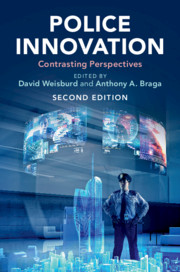Book contents
- Police Innovation
- Police Innovation
- Copyright page
- Contents
- Figures
- Tables
- Notes on Contributors
- Introduction
- Part I Community Policing
- Part II Procedural Justice Policing
- Part III Broken Windows Policing
- Part IV Problem–Oriented Policing
- Part V Pulling Levers (Focused Deterrence) Policing
- Part VI Third–Party Policing
- Part VII Hot Spots Policing
- 13 Advocate
- 14 Critic
- Part VIII Predictive Policing
- Part IX CompStat
- Part X Evidence-Based/ Risk-Focused Policing
- Part XI Technology Policing
- Index
- References
13 - Advocate
Hot Spots Policing as a Model for Police Innovation
from Part VII - Hot Spots Policing
Published online by Cambridge University Press: 09 August 2019
- Police Innovation
- Police Innovation
- Copyright page
- Contents
- Figures
- Tables
- Notes on Contributors
- Introduction
- Part I Community Policing
- Part II Procedural Justice Policing
- Part III Broken Windows Policing
- Part IV Problem–Oriented Policing
- Part V Pulling Levers (Focused Deterrence) Policing
- Part VI Third–Party Policing
- Part VII Hot Spots Policing
- 13 Advocate
- 14 Critic
- Part VIII Predictive Policing
- Part IX CompStat
- Part X Evidence-Based/ Risk-Focused Policing
- Part XI Technology Policing
- Index
- References
Summary
Looking at the major police innovations of the last few decades, what is most striking from a criminologist’s perspective is the extent to which new programs and practices have been developed without reference to either criminological theory or research evidence. Some institutional theorists might argue that this is understandable given the limited ability of police agencies to reliably demonstrate their successes, and the political environments within which police agencies must operate (Meyer & Rowan, 1977; Mastrofski & Ritti, 2000; Willis, Mastrofski & Weisburd, 2004). However, this reality is very much at odds with a model of policing that would seek to draw new policies and practices from a solid research base (Sherman, 1998; Weisburd & Neyroud, 2011), and suggests an approach to policing that is based more on intuition and luck than on research and experimentation. Studies of the adoption of police innovation reinforce this problematic portrait of American police innovation. Widely touted programs such as community policing or CompStat have been widely diffused across the landscape of American policing absent any reliable evidence that they accomplish the goals that they set out to achieve (Weisburd et al., 2003; Weisburd & Eck, 2004).
- Type
- Chapter
- Information
- Police InnovationContrasting Perspectives, pp. 291 - 313Publisher: Cambridge University PressPrint publication year: 2019
References
- 5
- Cited by



